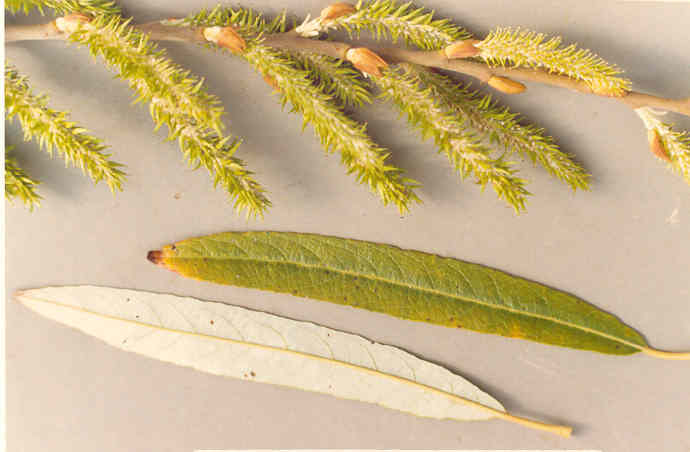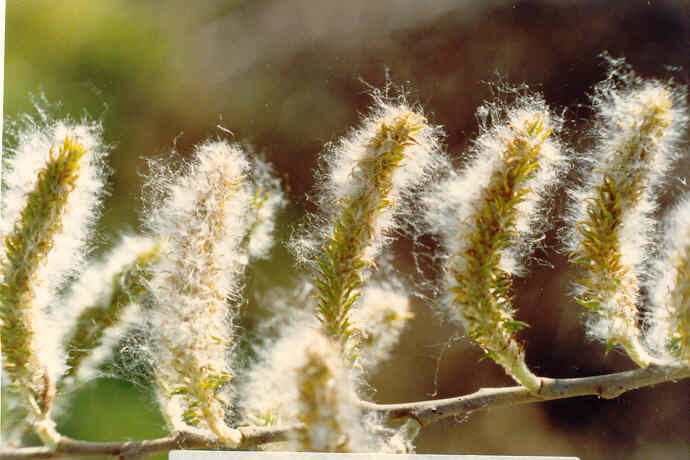
Salix lasiolepis Benth.
=Salix lasiolepis var. lasiolepis
 |
Salix lasiolepis Benth.=Salix lasiolepis var. lasiolepis
Salicaceae (Willow Family)NativeArroyo Willow |
January Photo
Plant Characteristics:
Erect shrub or small tree 2-10 m. high, with smooth bark and yellowish to
dark brown twigs, usually pubescent; lvs. oblanceolate, 6-10 cm. long, 1-2 cm.
wide, acute to obtuse; nearly entire, subrevolute, green and glabrous above,
pubescent to glabrate and glaucous beneath; petioles 3-12 mm. long; stipules
none or roundish; catkins mostly before the lvs., sub-sessile, 3-7 cm. long;
scales dark, round-obovate, 1 mm. long, densely hairy; stamens 2, the fils.
glabrous, united below; caps. 4.5-5 mm. long, glabrous; pedicels 0.5-1.2 mm.
long; styles 0.5 mm. long; stigmas short.
Habitat:
Common along streams, below 7000 ft.; cismontane Plant Communities to
montane Coniferous F., occasional in the desert; Santa Rosa, Santa Cruz Ids.; to
Wash., Rocky Mts. Bloom period not
listed in Munz. Varies from Jan. to
Sept. in my photos.
Name:
See S. gooddingii on origin of the genus name.
Greek, lasios, hairy, woolly and Greek, lepis, a scale.
(Jaeger 137,139). Referring to the
hairy scales.
General: Very common in the study area. Photographed on North Star Beach, the Santa Ana Heights Flats and along Back Bay Dr. at the north end of Eastbluff. (my comments). The Calif. Indians used the inner bark, in the spring, for rope. (ref. not recorded). Willows were used by the Indians for arrow shafts, spear shafts and tool handles. Willow was the original source of aspirin and was used by the Indians to cure fever. (lecture by Charlotte Clarke, author of Edible and Useful Plants of California, April 1987). One of the photos is of the red ball-like leaf gall caused by the sting of the gall sawfly, Pontania californica, which is really a wasp. (John Johnson). Another photo shows a small rosette of leaves which is another type of gall caused by Gall Midges, small flies of the Family Cecidomyiidae. (my comments). Asthma sufferers should not use aspirin as it could make it worse or even kill. Also, aspirin may be bad news for people with a bruise or black eye because it is an anticoagulant, meaning the blood won't clot as well and it will take longer to stop the bleeding that causes discoloration. (Prevention Magazine Editors 30, 62). The Mohave and Luiseno Indians of the southern portion of California, made a back skirt from the soft inner bark of cottonwood or willow. The small front piece sometimes came from the same bark but was usually an apron made of cords of fiber they normally used for string. (Campbell 211. Salix species have been known to cause hay fever and asthma. (Fuller 381). Willow is gathered from the time the leaves fall in autumn until the buds begin to swell in the spring. a green dye for coloring buckskin was created from boiling willow (Strike
1994).
Willow roots have been used to create a rose-tan dye. (Stevens, Michelle
L, "ETHNOECOLOGY OF SELECTED CALIFORNIA WETLAND PLANTS" FREMONTIA,
A Journal of the California Native Plant Society Vol. 32, No. 4
pp7-15). For additional information on uses of the willow see S. discolor, S.
exigua, and S. gooddingii.
Text Ref:
Hickman, Ed. 997; Mason 404; Munz, Flora So. Calif.
775.
Photo Ref:
Oct. 1 83 #2,3; Jan 2 84 # 8,9,18; Mar-April 84 # 8; April 1 84 # 11;
July 1 86 # 24A; Aug-Sept 87 # 13.
Identity: by R. De Ruff, confirmed by G. Marsh.
First Found: October 1983.
Computer Ref: Plant Data 273.
Have plant specimen.
Last edit 3/26/05.
 |
 |
February Photo February Photo